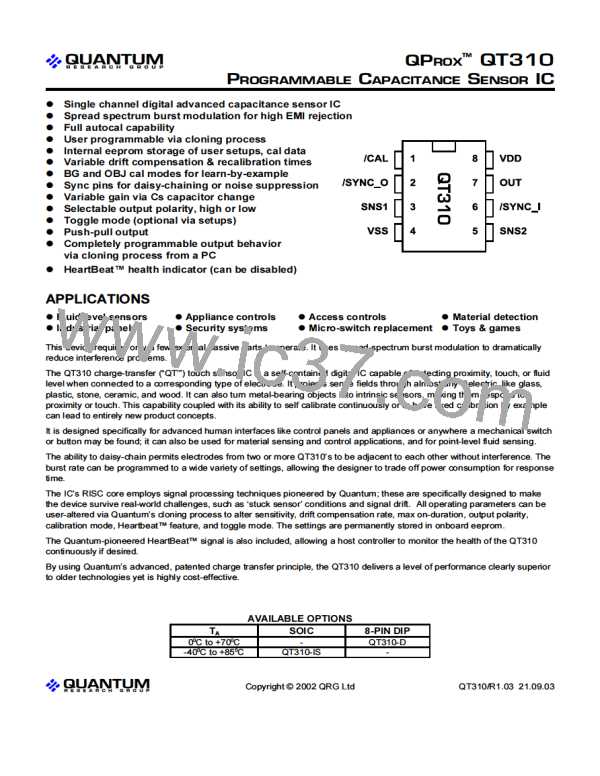This can be accomplished by minimising trace lengths and
widths.
1.3.2 KIRCHOFF
’
S
C
URRENT
L
AW
Like all capacitance sensors, the QT310 relies on Kirchoff’s
Current Law (Figure 1-4) to detect the change in capacitance
of the electrode. This law as applied to capacitive sensing
requires that the sensor’s field current must complete a loop,
returning back to its source in order for capacitance to be
sensed. Although most designers relate to Kirchoff’s law with
regard to hardwired circuits, it applies equally to capacitive
field flows. By implication it requires that the signal ground
and the target object must both be coupled together in some
manner for a capacitive sensor to operate properly. Note that
there is no need to provide actual hardwired ground
1.2.2 CONNECTION TO
E
LECTRODE
The PCB traces, wiring, and any components associated with
or in contact with SNS1 and SNS2 will become touch
sensitive and should be treated with caution to limit the touch
area to the desired location.
Multiple electrodes can be connected, for example to create a
control button on both sides of an object, however it is
impossible for the sensor to distinguish between the two
electrodes.
connections; capacitive coupling to ground (Cx1) is always
sufficient, even if the coupling might seem very tenuous. For
example, powering the sensor via an isolated transformer will
provide ample ground coupling, since there is capacitance
between the windings and/or the transformer core, and from
the power wiring itself directly to 'local earth'. Even when
battery powered, just the physical size of the PCB and the
object into which the electronics is embedded will generally
be enough to couple a few picofarads back to local earth.
The implications of Kirchoff’s law can be most visibly
demonstrated by observing the E3B eval board’s sensitivity
change between laying the board on a table versus holding
the board in your hand by it’s batteries. The effect can also be
observed by holding the board by the electrode ‘Sensor1’,
letting it recalibrate, then touching the battery end; the board
will work quite well in this mode.
Figure 1-3 Mesh Electrode Geometry
1.3.3 VIRTUAL
C
APACITIVE
G
ROUNDS
When detecting human contact (e.g. a fingertip), grounding of
the person is never required, nor is it necessary to touch an
exposed metal electrode. The human body naturally has
several hundred picofarads of ‘free space’ capacitance to the
local environment (Cx3 in Figure 1-4), which is more than two
orders of magnitude greater than that required to create a
return path to the QT310 via earth. The QT310's PCB
however can be physically quite small, so there may be little
‘free space’ coupling (Cx1 in Figure 1-4) between it and the
environment to complete the return path. If the QT310 circuit
ground cannot be grounded via the supply connections, then
a ‘virtual capacitive ground’ may be required to increase
return coupling.
1.2.3 BURST
M
ODE
O
PERATION
The acquisition process occurs in bursts (Figure 1-7) of
variable length, in accordance with the single-slope CDC
method. The burst length depends on the values of Cs and
Cx. Longer burst lengths result in higher gains and more
sensitivity for a given threshold setting, but consume more
average power and are slower.
Burst mode operation acts to lower average power while
providing a great deal of signal averaging inherent in the CDC
process, making the signal acquisition process more robust.
The QT method is a very low impedance method of sensing
as it loads Cx directly into a very large capacitor (Cs). This
results in very low levels of RF susceptibility.
1.3 ELECTRODE DESIGN
1.3.1 ELECTRODE
G
EOMETRY AND
S
IZE
There is no restriction on the shape of the electrode; in most
cases common sense and a little experimentation can result
in a good electrode design. The QT310 will operate equally
well with a long, thin electrode as with a round or square one;
even random shapes are acceptable. The electrode can also
be a 3-dimensional surface or object. Sensitivity is related to
electrode surface area, orientation with respect to the object
being sensed, object composition, and the ground coupling
quality of both the sensor circuit and the sensed object.
Smaller electrodes have less sensitivity than large ones.
If a relatively large electrode surfaces are desired, and if tests
show that an electrode has a high Cx capacitance that
reduces the sensitivity or prevents proper operation, the
electrode can be made into a mesh (Figure 1-3) which will
have a lower Cx than a solid electrode area.
Figure 1-4 Kirchoff’s Current Law
LQ
3
QT310/R1.03 21.09.03

 QUANTUM [ QUANTUM RESEARCH GROUP ]
QUANTUM [ QUANTUM RESEARCH GROUP ]